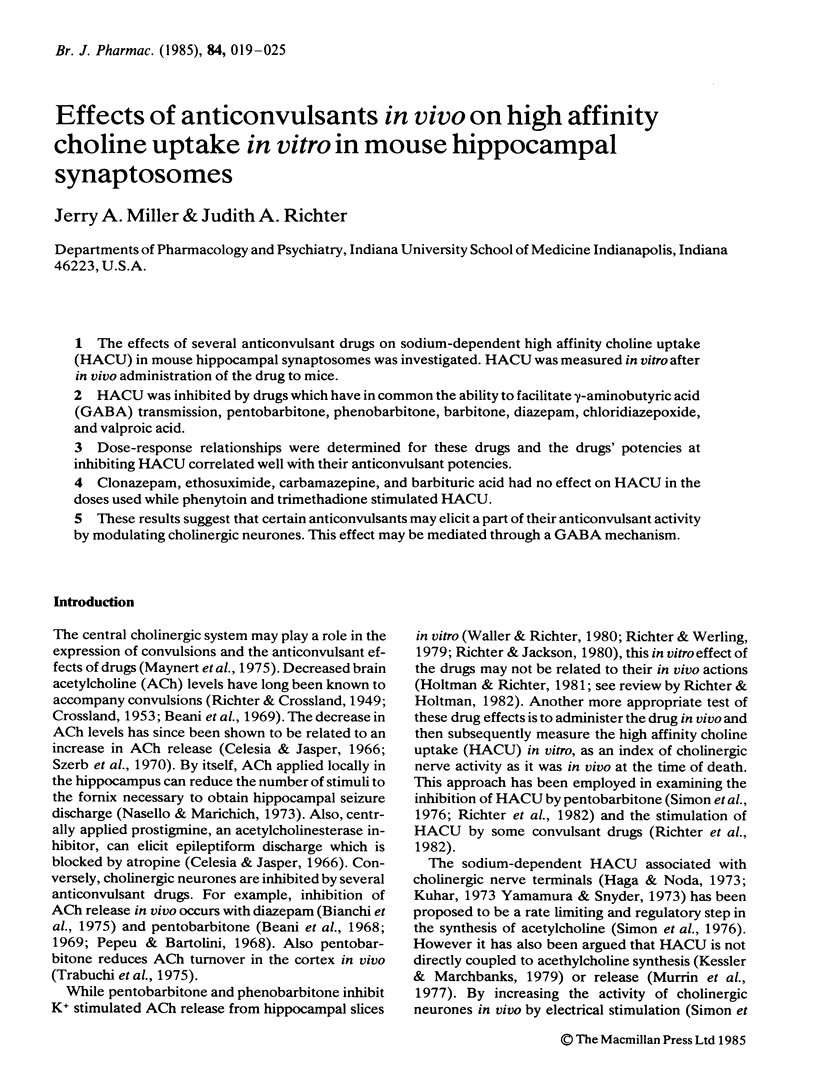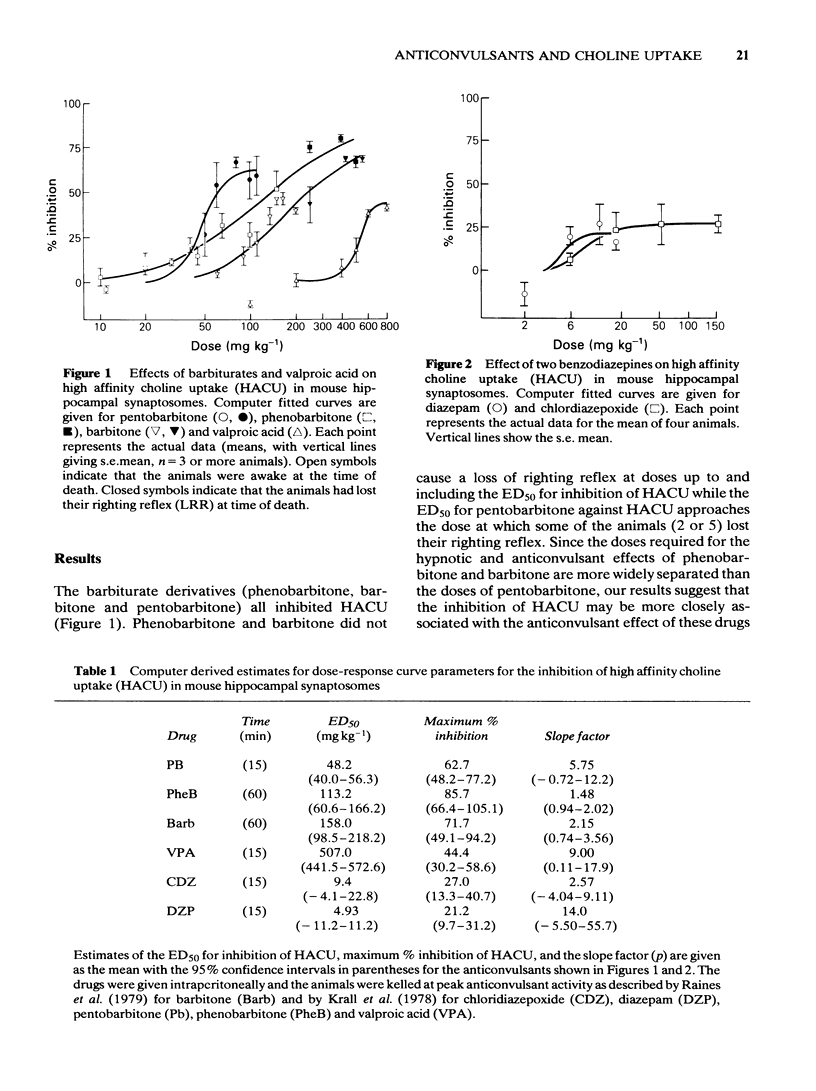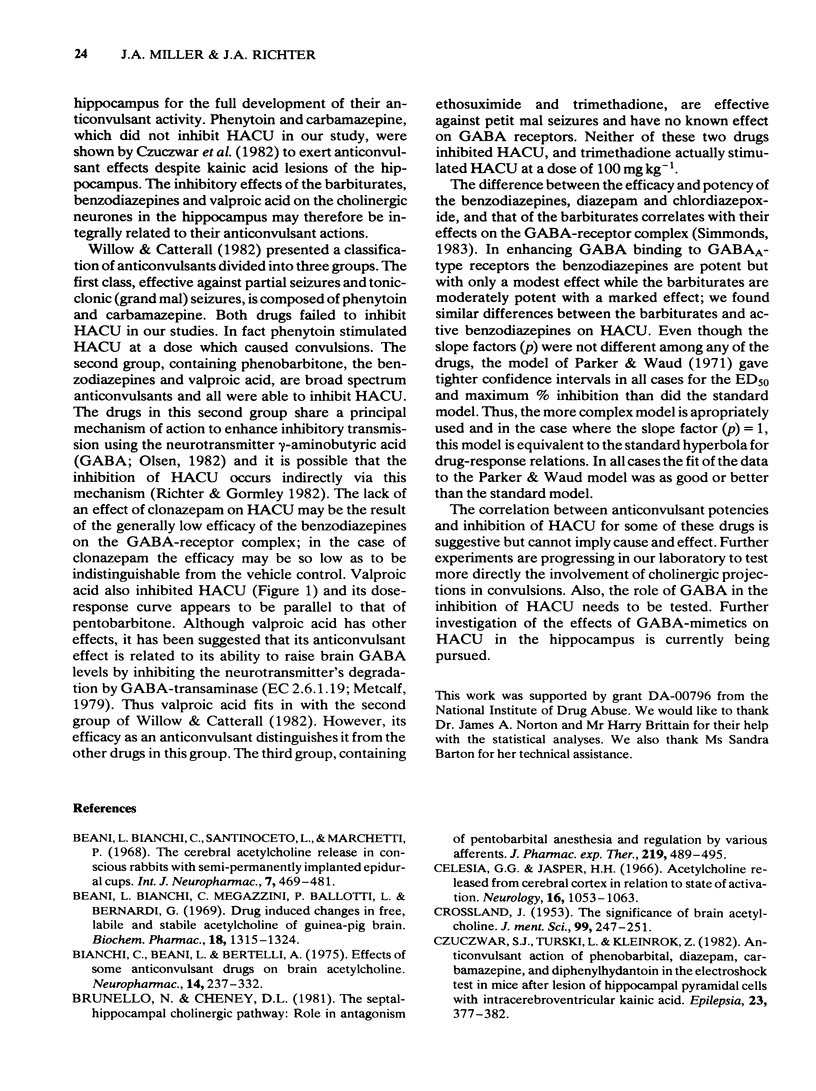Abstract
The effects of several anticonvulsant drugs on sodium-dependent high affinity choline uptake (HACU) in mouse hippocampal synaptosomes was investigated. HACU was measured in vitro after in vivo administration of the drug to mice. HACU was inhibited by drugs which have in common the ability to facilitate gamma-aminobutyric acid (GABA) transmission, pentobarbitone, phenobarbitone, barbitone, diazepam, chloridiazepoxide, and valproic acid. Dose-response relationships were determined for these drugs and the drugs' potencies at inhibiting HACU correlated well with their anticonvulsant potencies. Clonazepam, ethosuximide, carbamazepine, and barbituric acid had no effect on HACU in the doses used while phenytoin and trimethadione stimulated HACU. These results suggest that certain anticonvulsants may elicit a part of their anticonvulsant activity by modulating cholinergic neurones. This effect may be mediated through a GABA mechanism.
Full text
PDF






Selected References
These references are in PubMed. This may not be the complete list of references from this article.
- Beani L., Bianchi C., Megazzini P., Ballotti L., Bernardi G. Drug induced changes in free, labile and stable acetylcholine of guinea-pig brain. Biochem Pharmacol. 1969 Jun;18(6):1315–1324. doi: 10.1016/0006-2952(69)90244-5. [DOI] [PubMed] [Google Scholar]
- Beani L., Bianchi C., Santinoceto L., Marchetti P. The cerebral acetylcholine release in conscious rabbits with semi-permanently implanted epidural cups. Int J Neuropharmacol. 1968 Sep;7(5):469–481. doi: 10.1016/0028-3908(68)90046-4. [DOI] [PubMed] [Google Scholar]
- Bianchi C., Beani L., Bertelli A. Effects of some anti-epileptic drugs on brain acetylcholine. Neuropharmacology. 1975 May-Jun;14(5-6):327–332. doi: 10.1016/0028-3908(75)90013-1. [DOI] [PubMed] [Google Scholar]
- Brunello N., Cheney D. L. The septal-hippocampal cholinergic pathway: role in antagonism of pentobarbital anesthesia and regulation by various afferents. J Pharmacol Exp Ther. 1981 Nov;219(2):489–495. [PubMed] [Google Scholar]
- CROSSLAND J. The significance of brain acetylcholine. J Ment Sci. 1953 Apr;99(415):247–251. doi: 10.1192/bjp.99.415.247. [DOI] [PubMed] [Google Scholar]
- Celesia G. G., Jasper H. H. Acetylcholine released from cerebral cortex in relation to state of activation. Neurology. 1966 Nov;16(11):1053–1063. doi: 10.1212/wnl.16.11.1053. [DOI] [PubMed] [Google Scholar]
- Czuczwar S. J., Turski L., Kleinrok Z. Anticonvulsant action of phenobarbital, diazepam, carbamazepine, and diphenylhydantoin in the electroshock test in mice after lesion of hippocampal pyramidal cells with intracerebroventricular kainic acid. Epilepsia. 1982 Aug;23(4):377–382. doi: 10.1111/j.1528-1157.1982.tb05423.x. [DOI] [PubMed] [Google Scholar]
- Goldberg A. M., McCaman R. E. The determination of picomole amounts of acetylcholine in mammalian brain. J Neurochem. 1973 Jan;20(1):1–8. doi: 10.1111/j.1471-4159.1973.tb12097.x. [DOI] [PubMed] [Google Scholar]
- Haga T., Noda H. Choline uptake systems of rat brain synaptosomes. Biochim Biophys Acta. 1973 Jan 26;291(2):564–575. doi: 10.1016/0005-2736(73)90508-7. [DOI] [PubMed] [Google Scholar]
- Holtman J. R., Jr, Richter J. A. Comparison of the in vivo effects of convulsant and optically active hypnotic barbiturates with their effects on the in vitro K+-stimulated release of [3H]acetylcholine. Biochem Pharmacol. 1981 Sep 15;30(18):2619–2621. doi: 10.1016/0006-2952(81)90591-8. [DOI] [PubMed] [Google Scholar]
- Kessler P. D., Marchbanks R. M. Choline transport is not coupled to acetylcholine synthesis. Nature. 1979 Jun 7;279(5713):542–544. doi: 10.1038/279542a0. [DOI] [PubMed] [Google Scholar]
- Krall R. L., Penry J. K., White B. G., Kupferberg H. J., Swinyard E. A. Antiepileptic drug development: II. Anticonvulsant drug screening. Epilepsia. 1978 Aug;19(4):409–428. doi: 10.1111/j.1528-1157.1978.tb04507.x. [DOI] [PubMed] [Google Scholar]
- Kuhar M. J. Neurotransmitter uptake: a tool in identifying neurotransmitter-specific pathways. Life Sci. 1973 Dec 16;13(12):1623–1634. doi: 10.1016/0024-3205(73)90110-0. [DOI] [PubMed] [Google Scholar]
- Maynert E. W., Marczynski T. J., Browning R. A. The role of the neurotransmitters in the epilepsies. Adv Neurol. 1975;13:79–147. [PubMed] [Google Scholar]
- Metcalf B. W. Inhibitors of GABA metabolism. Biochem Pharmacol. 1979 Jun 1;28(11):1705–1712. doi: 10.1016/0006-2952(79)90529-x. [DOI] [PubMed] [Google Scholar]
- Murrin L. C., DeHaven R. N., Kuhar M. J. On the relationship between (3H)choline uptake activation and (3H)acetylcholine release. J Neurochem. 1977 Oct;29(4):681–687. doi: 10.1111/j.1471-4159.1977.tb07786.x. [DOI] [PubMed] [Google Scholar]
- Nasello A. G., Marichich E. S. Effects of some cholinergic, adrenergic and serotoninergic compounds, glutamic acid and GABA on hippocampal seizures. Pharmacology. 1973;9(4):233–239. doi: 10.1159/000136390. [DOI] [PubMed] [Google Scholar]
- Olsen R. W. Drug interactions at the GABA receptor-ionophore complex. Annu Rev Pharmacol Toxicol. 1982;22:245–277. doi: 10.1146/annurev.pa.22.040182.001333. [DOI] [PubMed] [Google Scholar]
- Parker R. B., Waud D. R. Pharmacological estimation of drug-receptor dissociation constants. Statistical evaluation. I. Agonists. J Pharmacol Exp Ther. 1971 Apr;177(1):1–12. [PubMed] [Google Scholar]
- Pepeu G., Bartolini A. Effect of psychoactive drugs on the output of acetylcholine from the cerebral cortex of the cat. Eur J Pharmacol. 1968 Oct;4(3):254–263. doi: 10.1016/0014-2999(68)90092-7. [DOI] [PubMed] [Google Scholar]
- RICHTER D., CROSSLAND J. Variation in acetylcholine content of the brain with physiological state. Am J Physiol. 1949 Nov;159(2):247–255. doi: 10.1152/ajplegacy.1949.159.2.247. [DOI] [PubMed] [Google Scholar]
- Raines A., Blake G. J., Richardson B., Gilbert M. B. Differential selectivity of several barbiturates on experimental seizures and neurotoxicity in the mouse. Epilepsia. 1979 Apr;20(2):105–113. doi: 10.1111/j.1528-1157.1979.tb04783.x. [DOI] [PubMed] [Google Scholar]
- Richter J. A., Gormley J. M., Holtman J. R., Jr, Simon J. R. High-affinity choline uptake in the hippocampus: its relationship to the physiological state produced by administration of barbiturates and other treatments. J Neurochem. 1982 Nov;39(5):1440–1445. doi: 10.1111/j.1471-4159.1982.tb12589.x. [DOI] [PubMed] [Google Scholar]
- Richter J. A., Gormley J. M. Inhibition of high affinity choline uptake in the hippocampus: studies on the site of pentobarbital action. J Pharmacol Exp Ther. 1982 Sep;222(3):778–785. [PubMed] [Google Scholar]
- Richter J. A., Holtman J. R., Jr Barbiturates: their in vivo effects and potential biochemical mechanisms. Prog Neurobiol. 1982;18(4):275–319. doi: 10.1016/0301-0082(82)90013-2. [DOI] [PubMed] [Google Scholar]
- Richter J. A., Jackson S. K. [3H]Acetylcholine and [3H]5-hydroxytryptamine release from rat midbrain slices and the effects of calcium and phenobarbital. Neurochem Res. 1980 Jul;5(7):719–730. doi: 10.1007/BF00964710. [DOI] [PubMed] [Google Scholar]
- Richter J. A., Werling L. L. K-Stimulated acetylcholine release: inhibition by several barbiturates and chloral hydrate but not by ethanol, chlordiazepoxide or 11-OH-delta9-tetrahydrocannabinol. J Neurochem. 1979 Mar;32(3):935–941. doi: 10.1111/j.1471-4159.1979.tb04578.x. [DOI] [PubMed] [Google Scholar]
- Simon J. R., Atweh S., Kuhar M. J. Sodium-dependent high affinity choline uptake: a regulatory step in the synthesis of acetylcholine. J Neurochem. 1976 May;26(5):909–922. doi: 10.1111/j.1471-4159.1976.tb06472.x. [DOI] [PubMed] [Google Scholar]
- Szerb J. C., Malik H., Hunter E. G. Relationship between acetylcholine content and release in the cat's cerebral cortex. Can J Physiol Pharmacol. 1970 Nov;48(11):780–790. doi: 10.1139/y70-113. [DOI] [PubMed] [Google Scholar]
- Trabucchi M., Cheney D. L., Racagni G., Costa E. Pentobarbital and in vivo turnover rate of acetylcholine in mouse brain and in regions of rat brain. Pharmacol Res Commun. 1975 Feb;07(1):81–94. doi: 10.1016/s0031-6989(75)80032-4. [DOI] [PubMed] [Google Scholar]
- Waller M. B., Richter J. A. Effects of pentobarbital and Ca2+ on the resting and K+-stimulated release of several endogenous neurotransmitters from rat midbrain slices. Biochem Pharmacol. 1980 Aug 15;29(16):2189–2198. doi: 10.1016/0006-2952(80)90197-5. [DOI] [PubMed] [Google Scholar]
- Willow M., Catterall W. A. Inhibition of binding of [3H]batrachotoxinin A 20-alpha-benzoate to sodium channels by the anticonvulsant drugs diphenylhydantoin and carbamazepine. Mol Pharmacol. 1982 Nov;22(3):627–635. [PubMed] [Google Scholar]
- Yamamura H. I., Snyder S. H. High affinity transport of choline into synaptosomes of rat brain. J Neurochem. 1973 Dec;21(6):1355–1374. doi: 10.1111/j.1471-4159.1973.tb06022.x. [DOI] [PubMed] [Google Scholar]


